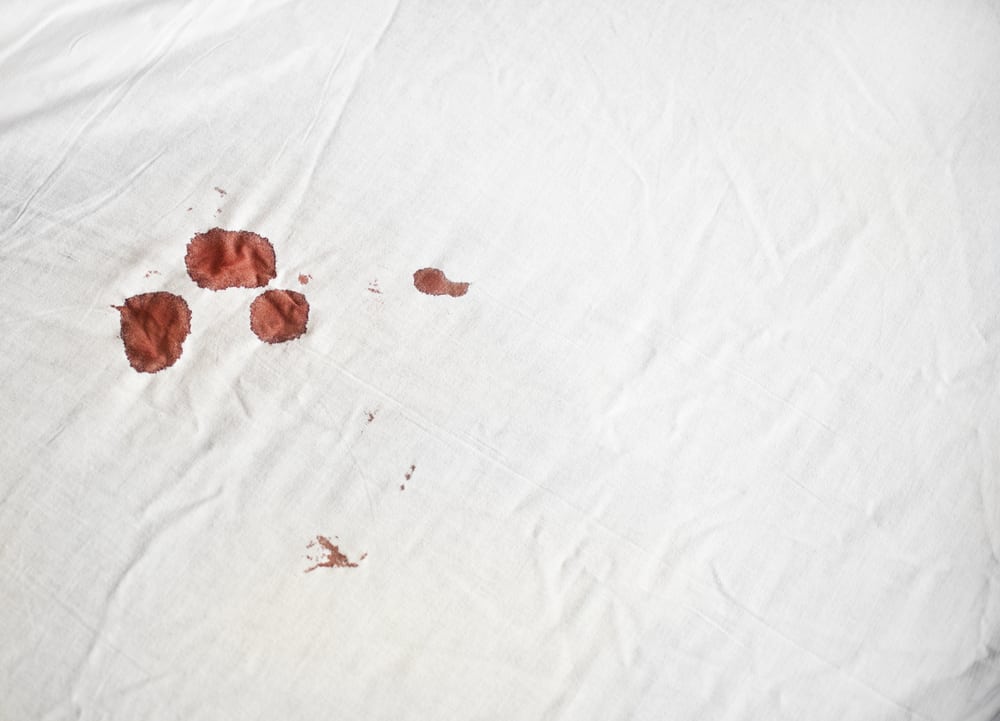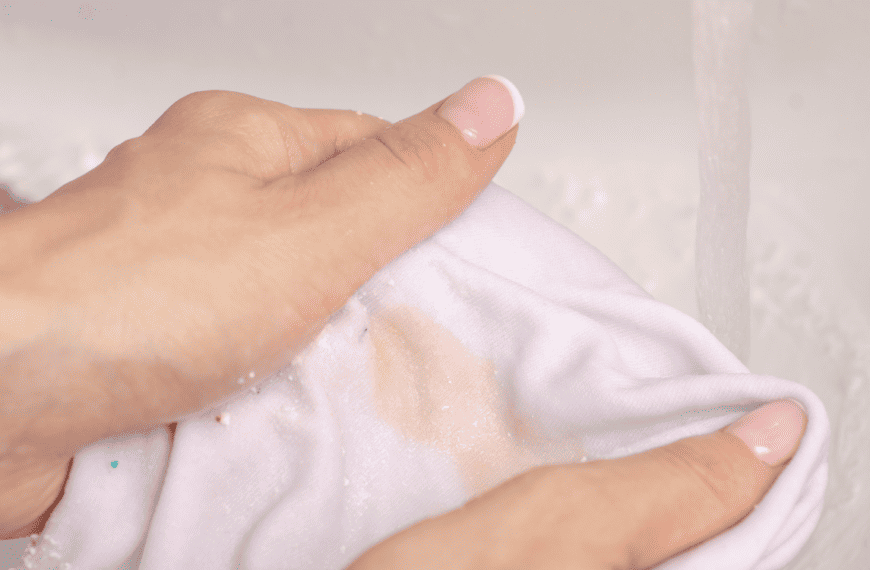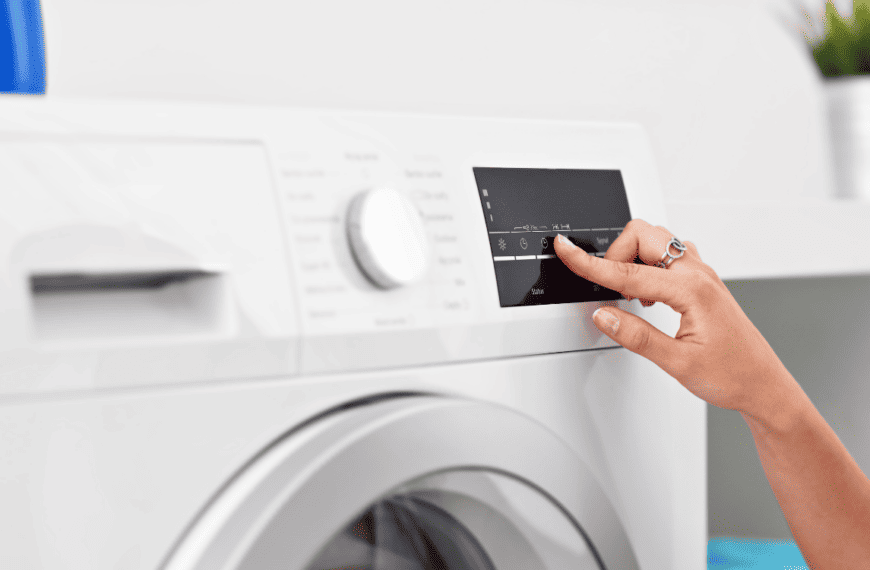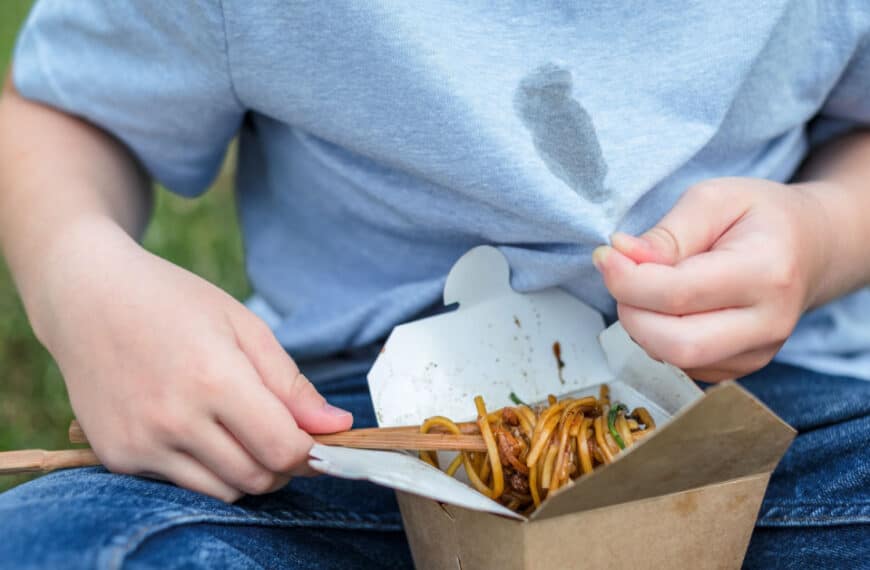One of the worst parts of blood on the sheets is that it dries before you have a chance to deal with it. You go to sleep with that mosquito bite or small scratch, and in the middle of the night, it opens up and stains the sheets. I’ll show you the method I use for removing blood from sheets, why it works, and what you can have on hand to save your sheets from these stains for good!
How To Remove Blood From Sheets
To remove blood from sheets, find a small spray bottle and fill it with hydrogen peroxide. Find the stain and spray it with the peroxide. Use a dry washcloth to blot the stain and pick up any excess blood. This method will work on dried blood stains as well as fresh blood stains. Hydrogen peroxide is a tremendous oxidizer, and it breaks down the proteins and the pigments in the blood so you can easily wash them out. Do a cold water wash with your sheets and check to make sure the stain is completely out before putting them in the dryer.
Important Things To Know Before Starting
Before you start removing blood from sheets, I want to make you aware of some of the properties of these stain remover options, as well as specifics related to the types of sheets on your bed.
- Try to get blood out of sheets as quickly as you can; dried blood stains have set in and are harder to remove
- Cold water will keep the blood proteins from coagulating and becoming stuck on the fabric; always use cold water
- Enzyme cleaners such as a pet stain remover are designed to break down proteins; delicate fabrics like wool and silk are protein based and can get damaged by using these cleaners
- Do a test on an inconspicuous area of the sheets before you use any stain remover; make sure it is not going to cause discoloration of the sheets
Methods for Removing Fresh Blood Stains From Sheets
I found this method for removing fresh blood stains from sheets after my husband started shaving his face at night. You can probably imagine how the rest of this story goes! I was tired of battling these blood stains in the wash the next day, so I used this hydrogen peroxide method, and it worked incredibly well.
- Take the sheets or pillowcase off the bed so that it is easier to work with
- Put hydrogen peroxide in a small spray bottle. I keep this bottle in our house to use on a variety of stains and cleaning projects
- Spray the stain (generously) so that it is wet
- You will see the blood breaking down as soon as you spray it
- Rinse with cold water, or dab with a cold washcloth
- Spray again if necessary
- Place sheets in the washing machine and do a cold wash (it doesn’t have to be extended, a quick wash is fine)
- When the sheets are done, check to make sure the stain is out; if it is, go ahead and dry the sheets in the dryer
Methods for Removing Dried Blood Stains From Sheets
Dried blood stains are a bit harder to remove because the blood has attached to the sheets a little more. Expect this process to take a little longer than the fresh blood stains.
- Remove the sheets from the bed, stubborn stains will need some extra attention to the stained area, and it’s best to take them off the bed
- Find an enzyme cleaner designed to break down proteins, like Puracy Stain Remover, and spray the stain. (Don’t use this on protein-based sheets like wool or silk)
- Rinse with cold water and then treat again with the enzyme stain remover
- Put the sheets in for a machine wash with cold water only; warm or hot water could make the stain removal process even more difficult
- Check if the stain is removed before putting the sheets in the dryer
- If the stain is still present, use the enzyme stain removers again; this time, use a little elbow grease to rub it into the stain
- Launder again and air dry if possible
Getting Blood Stain Out of Different Types of Sheets
Not only does the age of your stain matter when you clean blood stains but so does the type of fabric. Keep these things in mind as you decide which stain removers to use and avoid.
Cotton
Cotton sheets are some of the easiest to remove blood stains from. You can safely use enzyme stain removers. The key here is to avoid warm or hot water, as it can cause your sheets to shrink and set the blood stain in even further.
Linen
Linen fibers are not nearly as strong as other fabrics. I would avoid bleach completely, even fabric-safe bleach. Stick with mild liquid laundry detergent as a pre-treatment, mixed with a little cold water.
Bamboo
Bamboo does not like high heat, and neither do blood stained sheets. Stay far away from hot water here, and wash your sheets alone; bamboo sheets can get damaged if there are too many things in your washing machine.
Polyester
Polyester sheets are similar to cotton sheets in that they can handle enzyme cleaners. The big thing here is to stay away from hot water so you don’t set the stain deeper. I would also tumble dry or air dry the polyester sheets to avoid heat damage in the dryer.
Microfiber
Microfiber sheets respond well to my hydrogen peroxide method of stain removal. Use a clean cloth to keep blotting the stain and remove all excess blood. Avoid the desire to use warm or hot water here; you will damage the microfiber.
Satin
Satin sheets are delicate, and even when dealing with a fresh stain, you have to be careful not to damage the sheets. I would only use cold water and a few drops of mild laundry detergent to hand wash a blood stain. No enzyme cleaners and especially no bleach.
Silk
Silk is also a delicate material. Hand wash your silk sheets and gently rub a little extra mild laundry detergent into the stain to ensure that it is pre-treated. Hang your silk sheets to dry (out of the direct sunlight), and don’t wring them when wet to avoid damage.
How Do You Get Blood Out of Sheets Without Taking Them off the Bed?
If you are dealing with a fresh stain, a quick spray of hydrogen peroxide should get the blood out without you having to wash the sheets. I often put a washcloth under the stain, spray the sheet with a little peroxide, and then blot dry from the top. Make sure when you do get a chance to wash the sheets; you do it on a cold cycle.
Good Blood Stain Removers
If my best stain remover options from above were not a fit for your needs, here are some of the other options you can try for getting blood stains out of sheets. These should work on both old blood stains and new ones.
Cold Water
Cold water prevents a blood stain from setting and from spreading. Blot the blood stain with a washcloth that is covered in cold water. This method works best on fresh blood stains before the proteins in the blood have been attached to the sheets.
Enzyme Cleaner
Enzyme cleaners break down proteins; blood is made up of protein and pigments. Spray the enzyme cleaner directly on a cotton or polyester fabric, but never use it on silk or wool, or any delicate fabric. Rinse enzyme cleaners with cold water before putting in the washing machine with other fabrics.
Lemon Juice
Lemon juice is naturally acidic, which helps it break down the proteins in the blood. I would stay away from using lemon juice on satin or silk sheets to avoid damage from the acidity. Use pure liquid lemon juice or a fresh lemon and squeeze it on the stain, rinse with cold water, and repeat until the stain is removed. Then machine wash cold with like colors.
Hydrogen Peroxide
Hydrogen peroxide releases oxygen that helps to break down most blood stains. Hydrogen peroxide is safe on most fabrics, but it works best with white sheets. If you have very dark-colored sheets, there is a chance of peroxide fading the color in the sheets. Test in a small area first if you are concerned.
Salt
Salt is good at absorption, so it works well on a fresh blood stain. Rinse the stain first with cold water, sprinkle salt, and let it sit for about 15 minutes, rinse again and then wash and repeat until the stain no longer remains. Don’t put the sheets in the dryer until the stain comes out.
Baking Soda
Baking soda helps to absorb and then agitate the blood stain making it easier to remove. Use baking soda on any type of sheet except silk or satin, where it could be too abrasive. Get the blood stain wet, and then pour a little baking soda directly on the stain. Let it sit for a few minutes, add a few more drops of water and gently rub the blood stain to see if it releases. Add a few drops of liquid laundry detergent to the baking soda to make this more effective.
Cornstarch
Cornstarch will absorb fresh blood stains, but it is not an effective method for old blood stains. Cornstarch is safe on most fabrics as it is a bit milder than baking soda. Simply get the blood stain wet with cold water, sprinkle cornstarch, and let it absorb some of the blood.
Liquid Dish Soap
Liquid dish soap is safe on all fabrics except for silk and satin. Wash your blood stain with cold water and then rub liquid dish soap into the area. The dish soap works really well on fresh stains as a pre-treatment before putting it in the washing machine.
White Vinegar
White vinegar is very acidic, and that helps to break down the stains. I would not use this on delicate fabrics as it can be a little harsh with its acidity. Pour white vinegar directly on the stain, let it sit for about 10 minutes, and then use a cold, wet sponge to blot the stain. Place the sheets under cold running water to wash the vinegar out before laundering.
Ammonia
Ammonia works similarly to hydrogen peroxide in its ability to break down proteins in the blood. Not all stains require something as harsh as ammonia, and you should not use this on delicate fabrics like wool or silk. Ammonia needs to be mixed using one cup of water and one tablespoon of ammonia. Dip the end of a rag into the ammonia solution and use it to blot the blood stain; rinse before washing with other clothes.
Is Ammonia Safe To Use on Colored Sheets?
Ammonia is not safe to use on colored sheets. This stain removal product is a great stain fighter for grease and tough stains, but it can remove color from your sheets.
Toothpaste
Non-gel toothpaste is effective on blood stains because of its natural bleaching agent and abrasive properties. Squirt a little toothpaste directly on the blood stain, rub it in, rinse with cold water and wash with a mild laundry detergent. Toothpaste can be used on most fabrics, but be careful with delicate fabrics like silk or satin.
Bleach
Bleach will whiten the blood stain and even works to dissolve the toughest stains of dried blood. However, you can only use bleach on white sheets, as darker sheets will become discolored. Check the instructions on the bleach container to mix with water. Take the bleach mixture and blot the blood stain until the blood begins to break down and whiten.
Is It Safe To Use Bleach on Blood Stains?
Bleach is safe to use on blood stains, but you must only use it on white surfaces, and you have to ensure you have proper ventilation when working with bleach.
Commercial Product
The best commercial products for removing blood stains are enzyme-based stain removers. The enzymes break down proteins. The problem is you can’t use these on any bed sheet that is protein-based, like silk or wool. Puracy Stain Remover is a good option as it comes in a small spray bottle that you can spray directly on the blood stain. This product dissolves dried blood and fresh blood stains.
Cola
Cola is both acidic and carbonated, and it can be an effective stain fighter for blood on sheets. Stay away from Cola on white sheets as it can leave a brown color on the sheets, use this for darker colors. Place a little Cola on a sponge and blot the stain until the blood lightens. Get as much blood out as you can, and then put it through a machine wash.
Meat Tenderizer
Meat tenderizer is an enzyme based stain remover that breaks down proteins. Don’t use this on silk or wool. Make a paste similar to a baking soda paste, using a meat tenderizer and a little water. Let this sit on your stain for at least a half hour, rinse with cold water and then wash in the washing machine and air dry.
Understanding the Nature of Blood Stains
Blood stains are hard to remove. If you have struggled with blood stains in the past, it’s not you; it’s the nature of the stain. Here are some of the reasons why you struggle with blood stains and what you can do about it:
- Blood is a protein based stain, and proteins are hard to break down. Hemoglobin and fibrin are important for our body, but they make the stain resistant to traditional stain-fighting methods
- Blood is designed to clot when it comes into contact with the air. Therefore when you don’t treat a blood stain immediately, it has already done its job of setting into the sheets and becoming more difficult to remove
- Heat will set any blood stain, making it hard to remove; if your blood stained sheets got past you and made it into the dryer, your project is considerably more involved
- Blood also contains iron which can oxidize. When iron oxidizes, it becomes more difficult to treat and can cause additional discoloration in addition to the actual stain
Frequently Asked Questions (FAQs)
How To Get Blood Out of a Mattress?
To get blood out of a mattress, use a spray bottle filled with hydrogen peroxide and spray it directly on the mattress. Blot the stain with a clean cloth until all of the blood has been removed.
Can the Sun Really Help in Removing Blood Stains?
The sun can help to lighten a blood stain. However, you will still need an additional stain-fighting method to break down older or dried stains and pre-treat them before putting them in the washing machine.
Does Saliva Remove Blood Stains?
Saliva can work to remove a fresh blood stain. Spit on the stain and use a clean cloth to rub the saliva in. Rinse with cold water and then wash the stained cloth and sheets in cold water. Check to make sure the stain is removed before putting it in the wash.









